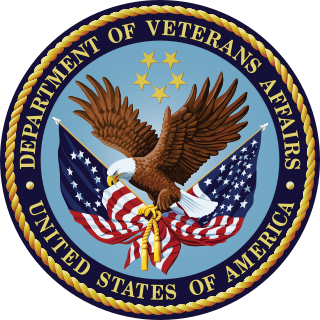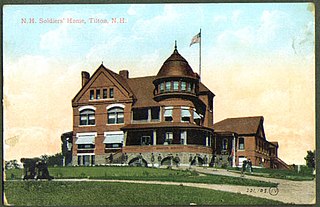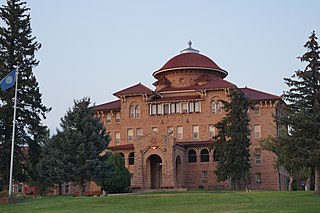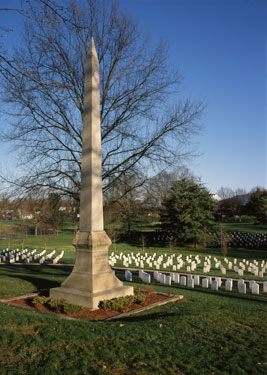
The United States Department of Veterans Affairs (VA) is a Cabinet-level executive branch department of the federal government charged with providing lifelong healthcare services to eligible military veterans at the 170 VA medical centers and outpatient clinics located throughout the country. Non-healthcare benefits include disability compensation, vocational rehabilitation, education assistance, home loans, and life insurance. The VA also provides burial and memorial benefits to eligible veterans and family members at 135 national cemeteries.

Brentwood is a suburban neighborhood in the Westside region of Los Angeles.

An old soldiers' home is a military veterans' retirement home, nursing home, or hospital, or sometimes an institution for the care of the widows and orphans of a nation's soldiers, sailors, and marines, etc.

The National Asylum for Disabled Volunteer Soldiers was established on March 3, 1865, in the United States by Congress to provide care for volunteer soldiers who had been disabled through loss of limb, wounds, disease, or injury during service in the Union forces in the American Civil War. Initially, the Asylum, later called the Home, was planned to have three branches: in the Northeast, in the central area north of the Ohio River, and in what was then considered the Northwest, the present upper Midwest.

Sawtelle is a district in the Westside of the city of Los Angeles, California, partially within the West Los Angeles subregion. It was established in 1899 and named after a manager of the Pacific Land Company who was initially responsible for its development and promotion.

Rancho San Vicente y Santa Mónica was a 33,000-acre (130 km2) Mexican land grant in present-day Los Angeles County, California given by governor Juan Alvarado in 1839 to Francisco Sepúlveda II, a soldier and citizen of Los Angeles. The rancho included what are now Santa Monica, Brentwood, Mandeville Canyon, and parts of West Los Angeles.

Wadsworth Chapel, also known as the Catholic-Protestant Chapels, is actually two separate chapels under one roof on the campus of the Dept. of Veterans Affairs Medical Center in West Los Angeles, California. The structure was built in 1900 and was closed in 1971 after being damaged in the 1971 Sylmar earthquake. It is the oldest building on Wilshire Boulevard and was listed in the National Register of Historic Places in 1972. The structure has fallen into a state of disrepair due to the lack of funds within the Dept. of Veterans Affairs to pay for the required repairs and renovation.

The Sawtelle Streetcar Depot is located on the grounds of the Sawtelle Veterans Home in Sawtelle, in the Westside area of Los Angeles, California.

Andrew Washington Barrett was a prominent Los Angeles businessman, adjutant general of the California National Guard, director of the Sawtelle Veterans Home, member of the governing body of the city of Los Angeles and a California state public official.

The National Home for Disabled Volunteer Soldiers, Marion Branch is a historic old soldiers' home located in Marion, Indiana. The hospital, along with Marion National Cemetery were listed on the National Register of Historic Places in 1999 as a national historic district.

The Westgate Line was a suburban route operated by the Pacific Electric Railway from 1911 to 1940. This line was one of four lines connecting Downtown Los Angeles and Santa Monica that did not run through Hollywood. The line is notable for taking a circuitous route towards its end, along San Vicente Boulevard, mainly because it was built to encourage construction of new homes near Pacific Palisades.

The Sawtelle Line was an interurban railway route primarily operated by the Pacific Electric Railway that ran between Downtown Los Angeles and Santa Monica, California. The line was established by the Pasadena and Pacific Railway between 1896 and 1901, with passenger service running until 1940.

The South Hollywood–Sherman Line was a suburban route of the Pacific Electric Railway. The line ran between Downtown Los Angeles and the suburb of Sherman. The line was named after Moses Sherman, who built the line and the Sherman street car yard on the line in West LA. The large 5.56-acre (2.25 ha) rail facility was on Santa Monica Boulevard just west of La Cienega Boulevard. The yard had a steam power house, a car barn and a shop building.

The Wadsworth Theatre, a historic live theater, is located in the Sawtelle community of West Los Angeles, California, within the 388-acre West Los Angeles Department of Veterans Affairs complex. Situated on Eisenhower Avenue in Building 226, the theater is part of the historic Sawtelle Veterans Home, nestled between Wilshire Boulevard and San Vicente Boulevard on the east side of Brentwood.

The Northwestern Branch, National Home for Disabled Volunteer Soldiers Historic District is a veterans' hospital located in Milwaukee, Wisconsin, with roots going back to the Civil War. Contributing buildings in the district were constructed from 1867 to 1955, and the 90 acres (36 ha) historic district of the Milwaukee Soldiers Home campus lies within the 400 acres (160 ha) Clement J. Zablocki VA Medical Center grounds, just west of American Family Field.
Wadsworth was an unincorporated community in Delaware Township, Leavenworth County, Kansas, United States. It is part of the Kansas City metropolitan area.

The Dayton Veterans Affairs Medical Center is located at 4100 West 3rd Street in Dayton, Ohio. Founded in 1867, it is one of the three oldest facilities of what is now the United States Department of Veterans Affairs. When founded, it was known as the Central Branch of the National Home for Disabled Volunteer Soldiers, and it is under this name that a portion of its campus, along with the adjacent Dayton National Cemetery, was designated a National Historic Landmark District in 2012, for its role in the history and management of veterans affairs.

The West Los Angeles Veterans Affairs Medical Center is among a network of housing, shelter, utilities, food preparation facilities and a hospital mandated to permanently serve veterans at the West Los Angeles VA Soldiers Home. The approximately 400 remaining acres of the Soldiers Home is located adjacent to the West Los Angeles, Westwood and Brentwood neighborhoods of Los Angeles, has its own ZIP code and accounts for most of the over $1,100,000,000 Greater Los Angeles VA Healthcare System's annual federal budget. Operated by the Veterans Health Administration, the West Los Angeles VA Soldiers Home is the first U.S. government facility for homeless Veterans and the only one it permanently maintains in public trust to house them.

The Mountain Branch, National Home for Disabled Volunteer Soldiers was an old soldiers' home opened in 1904 in Mountain Home, Johnson City, Tennessee. Its site has since been taken over by the United States Department of Veterans Affairs, and is home to the Mountain Home National Cemetery and the James H. Quillen VA Center. Also known as the Mountain Home, its campus was designated a National Historic Landmark District in 2011, as a well-preserved example of an early 20th-century veterans care facility.

The Battle Mountain Sanitarium was a division of the National Home for Disabled Volunteer Soldiers (NHDVS) located in Hot Springs, South Dakota. Established by law in 1902 and opened in 1907, it was unique among the facilities of the NHDVS, a precursor of today's United States Department of Veterans Affairs (VA), in that it was strictly a medical facility with no residential components beyond its treatment facilities. It was founded to treat former soldiers suffering from musculo-skeletal problems that were believed to be treatable by the region's mineral springs, and for conditions such as tuberculosis whose treatment was improved by the thin dry air. The facilities built for the sanitarium are in an architecturally distinctive Romanesque and Mission Revival style, and now form the centerpiece of the Black Hills Health Care facility, operated by the VA. Most of the complex site was designated a National Historic Landmark in 2011 for its architecture and history.





















